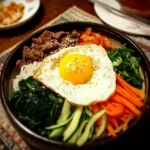The aroma alone is enough to transport me back to bustling Seoul markets, but the taste? That’s pure, unadulterated comfort and joy. This Authentic Bibimbap recipe isn’t just a meal in our household; it’s an event. The kids love pointing out their favorite colorful vegetables, and my partner and I relish the symphony of textures – the slight crunch of the carrots, the tender chewiness of the marinated beef, the silky egg yolk coating perfectly cooked rice, all brought together by that iconic, slightly sweet, deeply savory, and tantalizingly spicy gochujang sauce. The first time I made this exact version, following the traditional methods for preparing each component, the silence around the dinner table was broken only by appreciative murmurs and the clinking of spoons. It was a resounding success, and since then, it’s become a cherished regular, a vibrant testament to the beauty of Korean cuisine that never fails to satisfy. It’s more than just “mixed rice”; it’s a bowl full of love, history, and incredible flavor.
Bibimbap, translating literally to “mixed rice,” is more than just a dish; it’s a cornerstone of Korean cuisine, celebrated for its nutritional balance, vibrant presentation, and delightful interplay of flavors and textures. Each component is thoughtfully prepared and artfully arranged, creating a visually stunning meal that’s as pleasing to the eye as it is to the palate. This recipe focuses on delivering an authentic experience, capturing the essence of what makes Bibimbap a globally beloved dish. From the meticulously seasoned vegetables to the savory marinated beef and the iconic spicy-sweet gochujang sauce, every element plays a crucial role in the harmonious whole.
The beauty of Bibimbap lies in its versatility and the care taken with each individual ingredient. While it might seem like many steps, the process is straightforward, and the result is a deeply satisfying meal that can be customized to your liking. This version honors traditional preparations, ensuring a taste that is both genuine and unforgettable. Whether you’re a seasoned Korean food aficionado or new to the wonders of Bibimbap, this recipe will guide you to create a masterpiece in your own kitchen.
What is Bibimbap? A Culinary Introduction
Before diving into the recipe, let’s appreciate what makes Bibimbap so special. At its heart, Bibimbap is a rice bowl topped with an array of seasoned sautéed vegetables (namul), savory meat (usually beef), a fried or raw egg, and a dollop of gochujang (Korean chili paste). The act of vigorously mixing all these ingredients together just before eating is integral to the experience, transforming the neatly arranged components into a harmonious blend of flavors and textures.
Historically, Bibimbap was often eaten on the eve of the Lunar New Year to clear out leftover side dishes. It’s also known as a healthy, balanced meal, encompassing all essential food groups. Different regions in Korea boast their own variations, such as the famous Jeonju Bibimbap, known for its specific local ingredients and beef tartar. Our recipe aims for a classic, widely loved version that you can easily recreate.
Why This Authentic Bibimbap Recipe Works
This recipe is designed to bring out the authentic flavors of Bibimbap by:
- Individual Seasoning: Each vegetable component is seasoned and cooked separately. This might seem like extra work, but it’s crucial for developing distinct, clean flavors that complement each other rather than becoming muddled.
- Balanced Beef Marinade: The beef is marinated in a classic blend of soy sauce, sesame oil, garlic, and a touch of sugar, creating a tender, savory, and slightly sweet counterpoint to the vegetables and spicy sauce.
- Perfectly Cooked Rice: The foundation of any great Bibimbap is well-cooked short or medium-grain rice, which has the right stickiness to hold everything together when mixed.
- Homemade Gochujang Sauce: While store-bought gochujang is the base, we enhance it with a few simple ingredients to create a more nuanced and balanced sauce specifically for Bibimbap.
- The Egg: A sunny-side-up egg with a runny yolk adds richness and creaminess, binding the ingredients together when mixed.
The combination of these elements ensures a Bibimbap that is not just a collection of ingredients, but a cohesive and deeply satisfying culinary experience. The visual appeal, with its vibrant colors arranged like a painter’s palette, only adds to its charm.
Ingredients for Authentic Bibimbap (Serves 4)
This recipe calls for a variety of fresh vegetables and key Korean pantry staples. The amounts provided are for approximately 4 generous servings.
For the Rice:
- 2 cups short or medium-grain rice (e.g., Calrose or sushi rice), rinsed
- 2 ½ cups water (or as per rice cooker instructions)
For the Beef & Marinade:
- 1 lb (450g) beef sirloin, tenderloin, or ribeye, thinly sliced or julienned
- 3 tablespoons soy sauce
- 2 tablespoons toasted sesame oil
- 1 tablespoon mirin (or rice wine with 1/2 tsp sugar)
- 1 tablespoon minced garlic (about 2-3 cloves)
- 1 tablespoon granulated sugar (or brown sugar)
- 1 teaspoon freshly ground black pepper
- 1/2 teaspoon sesame seeds
For the Vegetables (Namul):
You will also need salt, toasted sesame oil, and minced garlic for seasoning most vegetables.
- Spinach:
- 10 oz (280g) fresh spinach, washed
- 1 teaspoon toasted sesame oil
- 1/2 teaspoon minced garlic
- 1/4 teaspoon salt (or to taste)
- Pinch of sesame seeds
- Carrots:
- 2 medium carrots (about 8 oz / 225g), julienned
- 1 teaspoon cooking oil (e.g., vegetable or canola)
- 1/2 teaspoon salt
- Zucchini:
- 1 medium zucchini (about 8 oz / 225g), julienned
- 1 teaspoon cooking oil
- 1/2 teaspoon salt
- Shiitake Mushrooms (or other mushrooms like oyster or button):
- 8 oz (225g) fresh shiitake mushrooms, stems removed, caps thinly sliced
- 1 tablespoon soy sauce
- 1 teaspoon toasted sesame oil
- 1/2 teaspoon minced garlic
- 1 teaspoon cooking oil
- Soybean Sprouts (Kongnamul) or Mung Bean Sprouts (Sukju Namul):
- 8 oz (225g) soybean sprouts or mung bean sprouts, rinsed
- 1 teaspoon toasted sesame oil
- 1/2 teaspoon minced garlic
- 1/4 teaspoon salt (or to taste)
- Pinch of sesame seeds
For the Gochujang Sauce (Bibimbap Sauce):
- 1/4 cup (60ml) gochujang (Korean chili paste)
- 2 tablespoons toasted sesame oil
- 1 tablespoon water (or more, for desired consistency)
- 1 tablespoon granulated sugar (or honey/corn syrup)
- 1 tablespoon rice vinegar
- 1 teaspoon minced garlic
- 1 teaspoon sesame seeds
For the Garnish & Assembly:
- 4 large eggs
- Toasted sesame oil (for drizzling, optional)
- Toasted sesame seeds
- Optional: Roasted seaweed (gim), julienned
Step-by-Step Instructions for Perfect Bibimbap
Preparing Bibimbap involves several components, but with a systematic approach, it’s quite manageable. The key is “mise en place” – having all your ingredients prepped and ready before you start cooking.
1. Prepare the Rice:
- Rinse the rice under cold water until the water runs mostly clear.
- Add the rinsed rice and 2 ½ cups of water to a rice cooker and cook according to the manufacturer’s instructions.
- Alternatively, cook on the stovetop: Bring rice and water to a boil in a medium saucepan. Once boiling, stir once, cover tightly, reduce heat to the lowest setting, and simmer for 15-20 minutes, or until all water is absorbed. Remove from heat and let stand, covered, for 10 minutes. Fluff with a fork. Keep warm.
2. Marinate and Cook the Beef:
- In a medium bowl, combine the thinly sliced beef with all the marinade ingredients: soy sauce, sesame oil, mirin, minced garlic, sugar, black pepper, and sesame seeds. Mix well to ensure the beef is evenly coated. Let it marinate for at least 20-30 minutes at room temperature, or longer in the refrigerator.
- Heat a tablespoon of cooking oil in a large skillet or wok over medium-high heat.
- Add the marinated beef and cook, stirring frequently, until it’s browned and cooked through (about 5-7 minutes). Avoid overcrowding the pan; cook in batches if necessary.
- Remove the cooked beef from the skillet and set aside.
3. Prepare the Vegetables (Namul):
For each vegetable, you’ll generally blanch or sauté, then season. Have small bowls ready for each seasoned vegetable.
- Spinach:
- Bring a pot of water to a boil. Add the spinach and blanch for 30-60 seconds, just until wilted.
- Immediately drain and rinse under cold water to stop the cooking process and retain its vibrant green color.
- Gently squeeze out excess water from the spinach.
- In a bowl, combine the blanched spinach with 1 teaspoon toasted sesame oil, 1/2 teaspoon minced garlic, 1/4 teaspoon salt, and a pinch of sesame seeds. Mix gently. Set aside.
- Soybean Sprouts (or Mung Bean Sprouts):
- If using soybean sprouts (kongnamul), you might want to remove the root ends for a cleaner look, though this is optional. Mung bean sprouts (sukju namul) are generally more tender.
- Bring a pot of water to a boil. Add the sprouts and cook for 2-3 minutes (for mung bean sprouts) or 5-8 minutes (for soybean sprouts, until tender but still slightly crisp).
- Drain and rinse under cold water. Gently squeeze out excess water.
- In a bowl, toss the sprouts with 1 teaspoon toasted sesame oil, 1/2 teaspoon minced garlic, 1/4 teaspoon salt, and a pinch of sesame seeds. Set aside.
- Carrots:
- Heat 1 teaspoon of cooking oil in the skillet over medium heat.
- Add the julienned carrots and 1/2 teaspoon salt. Sauté for 2-4 minutes, until tender-crisp. They should still have a slight bite.
- Remove from skillet and set aside.
- Zucchini:
- Heat 1 teaspoon of cooking oil in the same skillet over medium heat.
- Add the julienned zucchini and 1/2 teaspoon salt. Sauté for 2-3 minutes, until tender-crisp and slightly translucent. Be careful not to overcook, as it can become mushy.
- Remove from skillet and set aside.
- Shiitake Mushrooms:
- Heat 1 teaspoon of cooking oil in the skillet over medium-high heat.
- Add the sliced shiitake mushrooms and sauté for 3-5 minutes, until softened and slightly browned.
- Add 1 tablespoon soy sauce, 1 teaspoon toasted sesame oil, and 1/2 teaspoon minced garlic. Stir and cook for another 1-2 minutes until the mushrooms have absorbed the seasonings.
- Remove from skillet and set aside.
4. Prepare the Gochujang Sauce:
- In a small bowl, whisk together the gochujang, 2 tablespoons toasted sesame oil, water, sugar (or honey), rice vinegar, 1 teaspoon minced garlic, and 1 teaspoon sesame seeds.
- Adjust consistency with a little more water if it’s too thick. Taste and adjust sweetness or tanginess if desired. Set aside. This sauce is potent, so a little goes a long way.
5. Prepare the Eggs:
- Heat a lightly oiled non-stick skillet over medium-low heat.
- Crack the eggs into the skillet, being careful not to break the yolks.
- Cook sunny-side up until the whites are set but the yolks are still runny (about 2-4 minutes). Alternatively, cook to your preferred doneness (over easy, over medium).
6. Assemble the Bibimbap:
- Divide the warm cooked rice equally among 4 large, shallow bowls.
- Artfully arrange a portion of each prepared vegetable (spinach, sprouts, carrots, zucchini, mushrooms) and the cooked beef in separate sections on top of the rice. Aim for a colorful, visually appealing presentation, like petals of a flower.
- Carefully place a sunny-side-up egg in the center of each bowl.
- Garnish with extra toasted sesame seeds and, if desired, julienned roasted seaweed (gim).
- Serve immediately with the prepared Gochujang sauce on the side, allowing each person to add to their taste.
The Art of Assembling Your Bibimbap Bowl
While the instructions above cover the technical assembly, there’s an art to making your Bibimbap look as good as it tastes. Think of your bowl as a canvas:
- The Base: A generous bed of fluffy, warm rice is essential. Spread it evenly to create a stable foundation.
- Color Coordination: Arrange the vegetables in distinct piles around the perimeter of the bowl. Try to alternate colors to create a vibrant mosaic. For example, place the green spinach next to the orange carrots, and the pale sprouts next to the dark mushrooms.
- The Protein Star: The seasoned beef can be placed in its own section or nestled between vegetables.
- The Crowning Glory: The sunny-side-up egg sits proudly in the center, its golden yolk promising richness.
- Final Flourishes: A sprinkle of toasted sesame seeds over everything and perhaps some finely shredded gim (roasted seaweed) adds an extra layer of texture and nutty flavor.
The visual appeal is a significant part of the Bibimbap experience, whetting the appetite before the first bite.
Nutrition Facts
- Servings: 4
- Calories per serving: Approximately 650-750 kcal (This is an estimate and can vary significantly based on exact ingredient portions, type of beef, and amount of oil used.)
Bibimbap is generally considered a well-balanced meal, providing carbohydrates from rice, protein from beef and egg, healthy fats from sesame oil, and a wide array of vitamins and minerals from the diverse vegetables. The fiber content is also typically high due to the generous amount of vegetables.
Preparation Time
- Prep Time: 45-60 minutes (includes chopping vegetables and marinating beef)
- Cook Time: 30-40 minutes (includes cooking rice, beef, and each vegetable component)
- Total Time: Approximately 1 hour 15 minutes to 1 hour 40 minutes
While this might seem like a significant time investment, many steps can be done simultaneously. For instance, while the rice cooks and beef marinates, you can prep and cook the vegetables. The active cooking time for each component is relatively short.
How to Serve Your Authentic Bibimbap
Serving Bibimbap is an experience in itself, inviting interaction and personalization.
- Individual Bowls: Serve each portion in a large, wide bowl to allow ample space for mixing.
- The Mixing Ritual: This is the most crucial step before eating! Instruct diners to add their desired amount of Gochujang sauce (start with 1-2 tablespoons and add more if needed). Then, using a spoon (Koreans traditionally use a long-handled spoon), vigorously mix all the ingredients together – the rice, vegetables, beef, egg yolk, and sauce – until everything is well combined and the rice is tinged red from the sauce. Don’t be shy; a thorough mix ensures every bite is a perfect blend of flavors and textures.
- Gochujang on the Side: Always serve the Gochujang sauce separately so individuals can control the spice level. Some like it fiery, others prefer a milder touch.
- Accompaniments (Banchan): While Bibimbap is a complete meal, it’s often served with a side of kimchi. Other simple banchan (Korean side dishes) like pickled radishes (danmuji) or a light soup can also complement the meal.
- Drink Pairings:
- Barley Tea (Boricha): A common, mild, and nutty Korean tea often served with meals.
- Soju or Makgeolli: For an adult pairing, these traditional Korean alcoholic beverages are popular choices.
- Water: Simple and refreshing.
The communal joy of everyone mixing their bowls and customizing their spice level is part of what makes Bibimbap so enjoyable.
Additional Tips for Bibimbap Perfection
- Mise en Place is Your Best Friend: With many components, preparing everything beforehand (chopping, measuring out seasonings) makes the cooking process smooth and stress-free. Have small bowls ready to hold each cooked and seasoned vegetable.
- Don’t Overcook the Vegetables: Each vegetable should be cooked until tender-crisp (except spinach and sprouts, which are blanched until just wilted/tender). They should retain some texture and their vibrant color. Mushy vegetables will detract from the overall experience.
- The Rice Matters: Use good quality Korean short-grain or medium-grain rice. For an extra special touch, if you have a Korean stone bowl (dolsot), you can make “Dolsot Bibimbap.” Heat the oiled stone bowl until very hot, add the rice (it will sizzle and form a crispy bottom layer called nurungji), then arrange toppings as usual. The crispy rice adds an amazing textural contrast.
- Taste and Adjust Seasoning: While the recipe provides measurements, feel free to taste and adjust the seasoning for each vegetable component and the Gochujang sauce. Some may prefer things saltier, sweeter, or spicier.
- Get Creative with Toppings (Beyond the Basics): While this recipe covers classic toppings, feel free to experiment. Other popular additions include:
- Fernbrake (Gosari): A traditional mountain vegetable, often rehydrated and seasoned.
- Bellflower Root (Doraji): Another traditional root vegetable with a slightly bitter taste and crunchy texture.
- Kimchi: Finely chopped and sautéed kimchi can add another layer of flavor.
- Different Proteins: Try it with chicken, pork, tofu (for a vegetarian option), or even seafood.
Frequently Asked Questions (FAQ) about Bibimbap
Q1: Can I make Bibimbap vegetarian or vegan?
A: Absolutely! For a vegetarian version, simply omit the beef and ensure your Gochujang doesn’t contain fish products (most don’t, but it’s good to check). You can replace the beef with pan-fried tofu (marinated similarly to the beef), more mushrooms (like king oyster mushrooms), or edamame. For a vegan version, also omit the egg. You can add a drizzle of extra sesame oil or a creamy vegan sauce for richness.
Q2: What is the best type of rice to use for Bibimbap?
A: Short-grain or medium-grain white rice is traditional and highly recommended. Varieties like Calrose or “sushi rice” work perfectly. These types of rice have a slightly sticky texture that helps hold all the ingredients together when mixed. Avoid long-grain rice like Basmati or Jasmine, as it’s too dry and fluffy for Bibimbap.
Q3: Can I prepare any components of Bibimbap ahead of time?
A: Yes, many components can be prepped in advance.
* Vegetables: You can chop all your vegetables a day ahead. The seasoned vegetables (namul) can be cooked, seasoned, and stored in separate airtight containers in the refrigerator for up to 2-3 days.
* Beef: You can marinate the beef up to a day in advance and store it in the refrigerator. Cook it just before serving.
* Gochujang Sauce: The sauce can be made and stored in an airtight container in the refrigerator for up to a week.
* Rice & Egg: These are best made fresh just before serving for optimal texture and warmth.
Q4: Is Bibimbap very spicy? How can I adjust the spice level?
A: The spiciness of Bibimbap comes almost entirely from the Gochujang sauce, which means it’s highly customizable. Gochujang itself has varying levels of spiciness depending on the brand. If you are sensitive to spice, start by adding only a small amount of the prepared sauce (e.g., 1 teaspoon) to your bowl when mixing, and then add more to taste. You can also reduce the amount of Gochujang in the sauce recipe itself or dilute it further with a bit more water, sesame oil, or honey/sugar.
Q5: What is the difference between regular Bibimbap and Dolsot Bibimbap?
A: The main difference lies in the serving vessel and the resulting texture of the rice.
* Regular Bibimbap: Served in a standard bowl. The rice remains soft.
* Dolsot Bibimbap: Served in a very hot stone bowl (dolsot). Before adding the rice, the dolsot is typically coated with sesame oil and heated until scorching. When the rice is added, it sizzles and develops a coveted crispy, golden-brown layer on the bottom called “nurungji.” This crispy rice adds an incredible textural contrast to the soft toppings. The dolsot also keeps the meal hot throughout. If you have a dolsot, it’s highly recommended for an elevated Bibimbap experience!
This authentic Bibimbap recipe is your gateway to enjoying one of Korea’s most iconic and delicious dishes. While it involves several steps, each one contributes to the final, harmonious bowl. The vibrant colors, diverse textures, and explosion of flavors – from savory and sweet to spicy and umami – make every spoonful an adventure. Enjoy the process of creating this culinary masterpiece, and even more, enjoy the delightful experience of mixing and savoring your very own authentic Bibimbap.
Print
Authentic Bibimbap Recipe
Ingredients
For the Rice:
- 2 cups short or medium-grain rice (e.g., Calrose or sushi rice), rinsed
- 2 ½ cups water (or as per rice cooker instructions)
For the Beef & Marinade:
- 1 lb (450g) beef sirloin, tenderloin, or ribeye, thinly sliced or julienned
- 3 tablespoons soy sauce
- 2 tablespoons toasted sesame oil
- 1 tablespoon mirin (or rice wine with 1/2 tsp sugar)
- 1 tablespoon minced garlic (about 2–3 cloves)
- 1 tablespoon granulated sugar (or brown sugar)
- 1 teaspoon freshly ground black pepper
- 1/2 teaspoon sesame seeds
For the Vegetables (Namul):
You will also need salt, toasted sesame oil, and minced garlic for seasoning most vegetables.
- Spinach:
- 10 oz (280g) fresh spinach, washed
- 1 teaspoon toasted sesame oil
- 1/2 teaspoon minced garlic
- 1/4 teaspoon salt (or to taste)
- Pinch of sesame seeds
- Carrots:
- 2 medium carrots (about 8 oz / 225g), julienned
- 1 teaspoon cooking oil (e.g., vegetable or canola)
- 1/2 teaspoon salt
- Zucchini:
- 1 medium zucchini (about 8 oz / 225g), julienned
- 1 teaspoon cooking oil
- 1/2 teaspoon salt
- Shiitake Mushrooms (or other mushrooms like oyster or button):
- 8 oz (225g) fresh shiitake mushrooms, stems removed, caps thinly sliced
- 1 tablespoon soy sauce
- 1 teaspoon toasted sesame oil
- 1/2 teaspoon minced garlic
- 1 teaspoon cooking oil
- Soybean Sprouts (Kongnamul) or Mung Bean Sprouts (Sukju Namul):
- 8 oz (225g) soybean sprouts or mung bean sprouts, rinsed
- 1 teaspoon toasted sesame oil
- 1/2 teaspoon minced garlic
- 1/4 teaspoon salt (or to taste)
- Pinch of sesame seeds
For the Gochujang Sauce (Bibimbap Sauce):
- 1/4 cup (60ml) gochujang (Korean chili paste)
- 2 tablespoons toasted sesame oil
- 1 tablespoon water (or more, for desired consistency)
- 1 tablespoon granulated sugar (or honey/corn syrup)
- 1 tablespoon rice vinegar
- 1 teaspoon minced garlic
- 1 teaspoon sesame seeds
For the Garnish & Assembly:
- 4 large eggs
- Toasted sesame oil (for drizzling, optional)
- Toasted sesame seeds
- Optional: Roasted seaweed (gim), julienned
Instructions
1. Prepare the Rice:
- Rinse the rice under cold water until the water runs mostly clear.
- Add the rinsed rice and 2 ½ cups of water to a rice cooker and cook according to the manufacturer’s instructions.
- Alternatively, cook on the stovetop: Bring rice and water to a boil in a medium saucepan. Once boiling, stir once, cover tightly, reduce heat to the lowest setting, and simmer for 15-20 minutes, or until all water is absorbed. Remove from heat and let stand, covered, for 10 minutes. Fluff with a fork. Keep warm.
2. Marinate and Cook the Beef:
- In a medium bowl, combine the thinly sliced beef with all the marinade ingredients: soy sauce, sesame oil, mirin, minced garlic, sugar, black pepper, and sesame seeds. Mix well to ensure the beef is evenly coated. Let it marinate for at least 20-30 minutes at room temperature, or longer in the refrigerator.
- Heat a tablespoon of cooking oil in a large skillet or wok over medium-high heat.
- Add the marinated beef and cook, stirring frequently, until it’s browned and cooked through (about 5-7 minutes). Avoid overcrowding the pan; cook in batches if necessary.
- Remove the cooked beef from the skillet and set aside.
3. Prepare the Vegetables (Namul):
For each vegetable, you’ll generally blanch or sauté, then season. Have small bowls ready for each seasoned vegetable.
- Spinach:
- Bring a pot of water to a boil. Add the spinach and blanch for 30-60 seconds, just until wilted.
- Immediately drain and rinse under cold water to stop the cooking process and retain its vibrant green color.
- Gently squeeze out excess water from the spinach.
- In a bowl, combine the blanched spinach with 1 teaspoon toasted sesame oil, 1/2 teaspoon minced garlic, 1/4 teaspoon salt, and a pinch of sesame seeds. Mix gently. Set aside.
- Soybean Sprouts (or Mung Bean Sprouts):
- If using soybean sprouts (kongnamul), you might want to remove the root ends for a cleaner look, though this is optional. Mung bean sprouts (sukju namul) are generally more tender.
- Bring a pot of water to a boil. Add the sprouts and cook for 2-3 minutes (for mung bean sprouts) or 5-8 minutes (for soybean sprouts, until tender but still slightly crisp).
- Drain and rinse under cold water. Gently squeeze out excess water.
- In a bowl, toss the sprouts with 1 teaspoon toasted sesame oil, 1/2 teaspoon minced garlic, 1/4 teaspoon salt, and a pinch of sesame seeds. Set aside.
- Carrots:
- Heat 1 teaspoon of cooking oil in the skillet over medium heat.
- Add the julienned carrots and 1/2 teaspoon salt. Sauté for 2-4 minutes, until tender-crisp. They should still have a slight bite.
- Remove from skillet and set aside.
- Zucchini:
- Heat 1 teaspoon of cooking oil in the same skillet over medium heat.
- Add the julienned zucchini and 1/2 teaspoon salt. Sauté for 2-3 minutes, until tender-crisp and slightly translucent. Be careful not to overcook, as it can become mushy.
- Remove from skillet and set aside.
- Shiitake Mushrooms:
- Heat 1 teaspoon of cooking oil in the skillet over medium-high heat.
- Add the sliced shiitake mushrooms and sauté for 3-5 minutes, until softened and slightly browned.
- Add 1 tablespoon soy sauce, 1 teaspoon toasted sesame oil, and 1/2 teaspoon minced garlic. Stir and cook for another 1-2 minutes until the mushrooms have absorbed the seasonings.
- Remove from skillet and set aside.
4. Prepare the Gochujang Sauce:
- In a small bowl, whisk together the gochujang, 2 tablespoons toasted sesame oil, water, sugar (or honey), rice vinegar, 1 teaspoon minced garlic, and 1 teaspoon sesame seeds.
- Adjust consistency with a little more water if it’s too thick. Taste and adjust sweetness or tanginess if desired. Set aside. This sauce is potent, so a little goes a long way.
5. Prepare the Eggs:
- Heat a lightly oiled non-stick skillet over medium-low heat.
- Crack the eggs into the skillet, being careful not to break the yolks.
- Cook sunny-side up until the whites are set but the yolks are still runny (about 2-4 minutes). Alternatively, cook to your preferred doneness (over easy, over medium).
6. Assemble the Bibimbap:
- Divide the warm cooked rice equally among 4 large, shallow bowls.
- Artfully arrange a portion of each prepared vegetable (spinach, sprouts, carrots, zucchini, mushrooms) and the cooked beef in separate sections on top of the rice. Aim for a colorful, visually appealing presentation, like petals of a flower.
- Carefully place a sunny-side-up egg in the center of each bowl.
- Garnish with extra toasted sesame seeds and, if desired, julienned roasted seaweed (gim).
- Serve immediately with the prepared Gochujang sauce on the side, allowing each person to add to their taste.
Nutrition
- Serving Size: One Normal Portion
- Calories: 650-750





